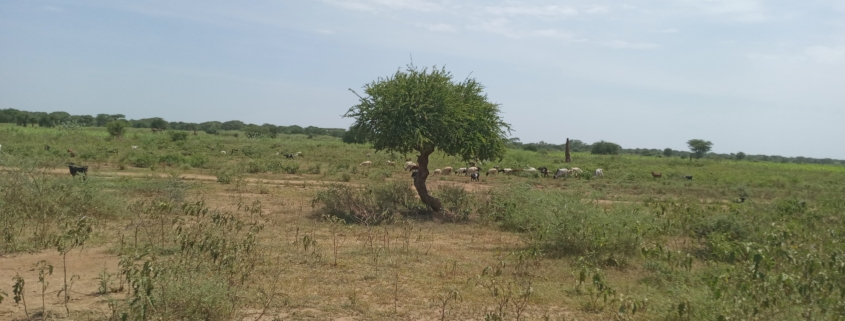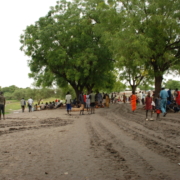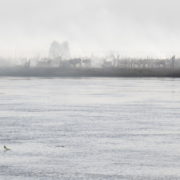Kapoeta, a semi-arid area,[1] has been experiencing severe drought conditions since 2021 caused by climate change.[2] The changing conditions have reportedly resulted in the spread of invasive weed species in the last two to three years. These include Beku (local name) with the scientific name Prosopis Juliflora and Abonglogir (local name) with the scientific name Parthenium.
Invading farms, grazing land and roadsides, these weeds have a devastating impact on livelihoods, such as farming and livestock keeping in Kapoeta.[3] They are more resilient to drought and outcompete with food crops and animal pastures for water and land, thereby leading to reduced production of food crops and fodder for livestock. Additionally, they are inedible and even poisonous, especially Parthenium. Globally, weeds, including pests, presumably contribute to a 40% decline in global crop production.[4]
Most respondents of recent Climate Change and Conflict research[5] conducted for the Conflict Sensitivity Resource Facility (CSRF) in Kapoeta believe that Parthenium weed reached the area through imported seeds distributed by aid agencies, and that aid agencies might be responsible for drought. The spread of the weeds and the associated perceptions present conflict sensitivity challenges to aid operations in Kapoeta and beyond. Against this backdrop, this blog attempts to highlight the conflict sensitivity risks associated with spreading of the weeds and aridity and ways to mitigate these risks. Based on the CSRF Climate Change and Conflict research, this blog discusses the nature of the problem, its effect and causes, and provides some conflict sensitive considerations.
The effects of the weeds: gender and conflict related implications
These weeds are blamed for dominating and damaging food crops and animal pasture. Besides that, they allegedly contribute to allergic reactions including body itching, a phenomenon that is backed by scientific evidence elsewhere.[6] Lastly, the weeds, especially Parthenium, has supposedly caused displacement. For instance, two years ago the entire population of the logir clan in a village in Nyangia area of Kapoeta East county was forced to relocate after the weeds had damaged their crops and pasture, causing hunger. This displacement led to the naming of the weed as Abonglogir or the weed that has chased the logir clan.
Moreover, these weeds impact men and women differently. Women who predominantly engage in farming and are responsible for providing food for their families are negatively affected by weeds. These weeds cause reduced crop yields, which contribute to gender-based violence by men, who abuse their wives for failing to provide food. However, the weeds also affect men who mostly engage in livestock keeping. They do so by colonising and destroying nutritious pasture for animals. The resulting shortage of pasture forces men to migrate and encroach into foreign territories for water and pasture. This migration recurrently leads to competition and violence with neighboring communities, such as Didinga, Boya (South Sudan) and Turkana (Kenya).
Evolving narratives on the origin of the weeds and the perceived link to aid operations
Communities in Kapoeta trace the origin of the above-described two invasive weeds to two sources. They claim a foreigner brought and planted Prosopis Juliflora or Beku weed seven years ago. However, this claim is hard to verify. What is a more evidence-based explanation for the introduction of the weed in Kapoeta is that it has encroached from the neighbouring Turkana region of Kenya.[8]
Moreover, respondents in Kapoeta allege that Parthenium or Abonglogir, which is said to have originated from South America, was introduced through imported seeds distributed by aid agencies. Although this claim has not been affirmed in Kapoeta, available scholarly evidence elsewhere suggests that Parthenium weed was introduced to many countries through the import of pasture, feeds and seeds.[9] Regardless of the weed’s perceived foreign origin, including the alleged link to aid agencies, the increasing aridity in Kapoeta linked to the changing climate seems to be the main factors causing the spreading of these weeds.
Furthermore, in Kapoeta, some people seemingly link aid agencies with climate change. During the climate change research, one respondent referred to the allegation that aid agencies might be contributing to drought. For example, an aid agency staff member narrated that their use of head torches at night in a village in Kapoeta created the suspicion that they were conducting a ritual with their head torches to influence rainfall patterns.[10] As a result of the suspicion, the aid agency staff members had to evacuate overnight from the village for fear of their lives.[11]
Conflict sensitivity considerations
The narratives around the origins of these weeds pose conflict sensitivity risks: The widespread perception that aid agencies are responsible for bringing the weeds creates a negative view of aid agencies and could undermine their legitimacy and, as a result, put project implementation in jeopardy. Moreover, the example of the allegation that aid agencies contribute to drought illustrates that such allegations can pose a security threat to agency staff members. Therefore, donors and aid agencies ought to consider the following conflict sensitivity considerations in both drought and flood affected areas across the country:
- They should prioritise community engagement and understanding of the context in their operations to ensure that perspectives of local communities inform the design of projects.
- They should assess the magnitude of the spread of weeds and the related implication on gender and violence so as to design activities in gender and conflict sensitive way.
- They should revisit responses of communities and aid agencies in neighboring countries in order to learn about potential benefits that weeds can provide to local communities at large.
- They should ensure aid sourced from outside is packed and shipped responsibly to reduce the introduction of new weeds and pests in receiving places. This can help ensure that humanitarian, development and peacebuilding interventions do not worsen the already dire situation.
- They should leverage funding to prevent and control the spread of the weeds in a conflict sensitive way in partnership with communities. This can help in the fight against the weeds and provide hope for local communities.
- They should explore other effective measures for controlling the spread of the weeds based on lessons learned from other contexts and adapt their activities accordingly.
- They should seek to strengthen livelihoods of local communities and build their resilience in the face of the spreading weeds.
All kinds of invasive weeds are spreading worldwide, and South Sudan is not an exception. Whilst their impact is felt more in some places in the country than others, it does not mean they are absent or do not pose a risk in these places. Also, the perception that aid agencies might be spreading the weeds presents a severe risk to aid operations beyond Kapoeta. Thus, aid agencies should consider conflict sensitivity risks related to Climate Change and aid in areas affected by both drought and flooding.
[1] Kapoeta area, which borders Kenya and Ethiopia, consists of Kapoeta East, Kapoeta North and Kapoeta South counties.
[2] REACH (2022), ‘Greater Kapoeta climate impact and displacement profile, Eastern Equatoria State, South Sudan’ March; CSRF (2023), ‘Climate change and conflict research’ May
[3] Ibid REACH (2022) and CSRF (2023)
[4] Reliefweb (2023), ‘Unceasing Human Attacks on the Source of 80% of Food, 98% of Oxygen,’ May
[5] This research was conducted between October and November 2022, and it was looking at the intersection between conflict and climatic events, such as drought and flooding.
[6] Op cit., CSRF (2023)
[7] See Kaur et al., 2014. Effects and Management of Parthenium hysterophorus: A Weed of Global Significance. Link: https://www.ncbi.nlm.nih.gov/pmc/articles/PMC4897546/#:~:text=Physical%20Control,increase%20the%20area%20of%20infestation.
[8] See P. Maundu, S. Kibet, Y. Morimoto, M. Imbumi & R. Adeka (2009) Impact of Prosopis juliflora on Kenya’s semi-arid and arid ecosystems and local livelihoods, Biodiversity, 10:2-3, 33-50, DOI: 10.1080/14888386.2009.9712842
[9] See Matzrafi, M., Raz, H., Rubin, B., Yaacoby, T., & Eizenberg, H. (2021). Distribution and biology of the invasive weed Parthenium hysterophorus L. in Israel. Frontiers in Agronomy, 3, 639991.
[10] In Eastern Equatoria state, including Kapoeta, there exist a belief that individuals, especially spiritual leaders have supernatural powers to influence rain.
[11] Interview with a female NGO STAFF, October 2022, Kapoeta Town





